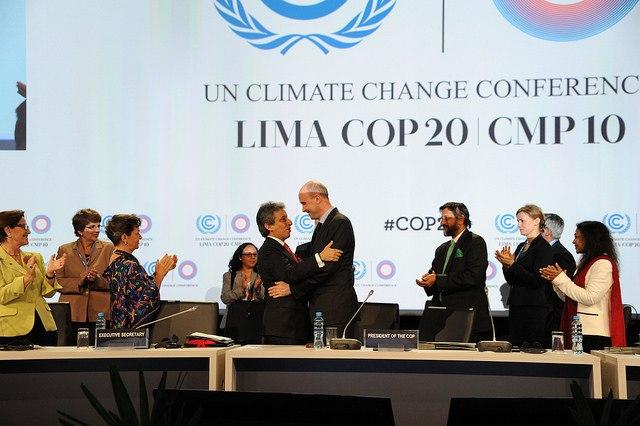
By Jeff Hayward
I recently returned to the U.S. from Lima, where I was part of a delegation to COP20 from the NGO Rainforest Alliance. Coverage of it ranges from cheers and applause to anger and frustration, but my own experience is somewhere in between.
There is reason to criticize what the Lima agreement didn’t say. It called for countries to submit their action pledges in advance of COP21 in Paris next year, but didn’t specify what those pledges needed to include or how they’ll be reviewed. But it was progress that, for the first time, all nations agreed to take responsibility for their greenhouse gas emissions. For all the delay and brinksmanship of the negotiations, COP20 was also an affirmation that all nations, developed and developing alike, have important contributions to make.
Last week in Lima, pledges to the Global Climate Fund topped $10 billion, with new contributions not only from wealthy nations like Belgium and Australia, but also from developing forest nations like Peru and Colombia.
It’s remarkable that Latin American nations whose people depend mostly on resource-based livelihoods like forestry, ranching and farming are starting to contribute to the GCF. It points to tropical countries’ role as full partners, not so much as funders -- there’s no question that most funding must come from developed nations – but as the actors with the most to contribute to emissions reductions from agriculture, forestry and other land use (known by the acronym “AFOLU”).
AFOLU is the second-biggest emitter of greenhouse gases, accounting for a quarter of global GHG emissions. Plowing, fertilizing, grazing and burning generate vast amounts of GHG, and agriculture drives deforestation which generates even more, especially for carbon-rich tropical forests. The U.N. Climate Summit in September called for eliminating deforestation by 2030. That would be like taking all the world’s cars off the road or eliminating all U.S. emissions. Yet as population and food demand rise, pressures on farmers and forests are growing. That’s why agriculture and forestry were prominent in Lima, and why national, bilateral and multilateral initiatives announced in these areas are hopeful outcomes of the meeting.
The Global Landscapes Forum at COP20 attracted thousands of policy and business leaders in to discuss frameworks and financing for sustainable agriculture and forestry. “We know that climate change cannot be tackled without a fundamental change in the way that agriculture is practiced,” Unilever CEO Paul Polman told the Forum.
Unilever was an early adopter of that view, committing to source all agricultural raw materials sustainably by 2020 and eliminate deforestation from its supply chain. But COP20 showcased a growing trend of tropical countries taking their own initiatives to cut emissions from land use.
For example, 13 tropical countries announced the Lima Challenge, pledging to go further in their efforts to stop deforestation, while challenging other producer countries to follow suit and for donor countries to support them.
Seven Latin American and Caribbean countries launched Initiative20x20 to restore 20 million hectares of degraded land to a combination forest, agroforestry and plantation by 2020, and that’s just the beginning, say the organizers. To get an idea how far-reaching this could be, see this report which finds that restoring just 12 percent of the world’s degraded land to productive use could feed 200 million people while cutting GHGs.
The Peruvian government presented its iNAMAzonia program (NAMA stands for “Nationally Appropriate Mitigation Actions”), for which my organization the Rainforest Alliance is providing technical support. A significant part of the Peruvian Amazon is degraded land where farmers have carved out coffee, cacao, oil palm and livestock production. By working with them to make their operations more sustainable and productive, iNAMAzonia relieve pressure on the surrounding forests and prevent future deforestation.
I’m not implying that responsibility for acting on climate change somehow lies with tropical countries, which are generally the ones least responsible for the causes and suffer most with the effects. Developed countries must lead on cutting their own emissions and on financing initiatives like the ones above.
What I am saying is that cutting emissions from land use by ending deforestation and transforming agriculture are essential to climate solutions, and that the initiative of tropical countries showcased at Lima is a sign that we’re actively building the mechanisms to accomplish it. As Leandro Salina, a coffee farmer in Mexico’s Oaxaca region working with Rainforest Alliance to implement climate-friendly farming practices, says in this video, “Even though we know we aren’t causing [climate change] – it’s others who are causing it – we, too must do something.” Such attitudes are noble, but more than that, they’re of great practical significance for global emissions, and a source of hope for the climate.
Image credit: Flickr/UNclimatchange
Jeff Hayward is the director of the Rainforest Alliance's climate program.
TriplePundit has published articles from over 1000 contributors. If you'd like to be a guest author, please get in touch!














